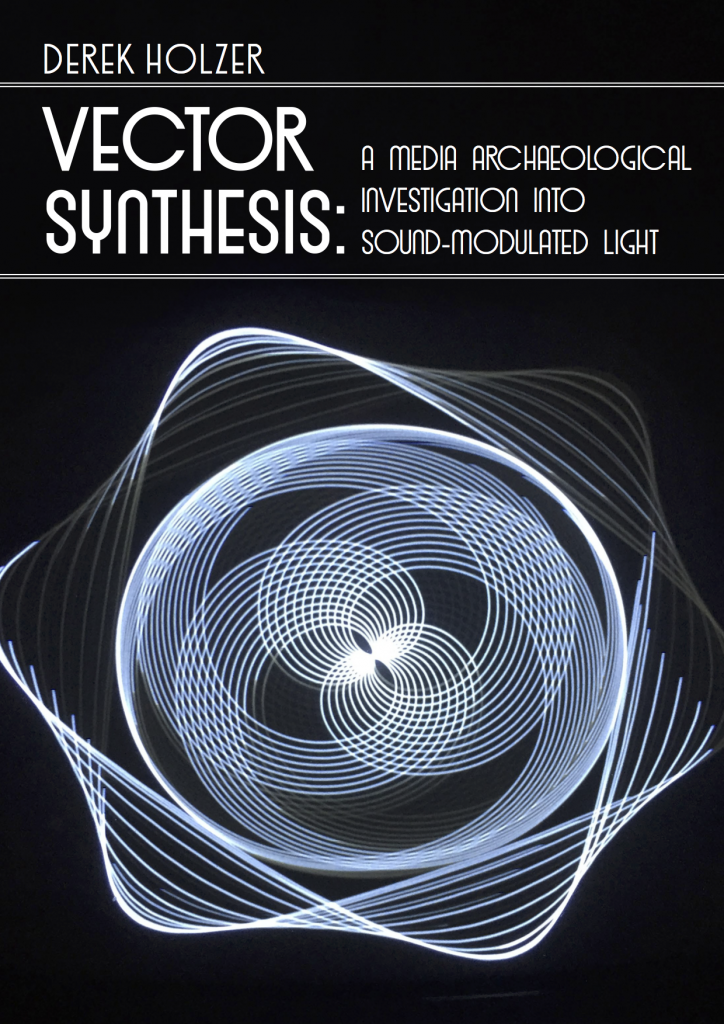Book: Vector Synthesis

Vector Synthesis: a Media Archaeological Investigation into Sound-Modulated Light is a computational art project inspired by theories of media archaeology, by the history of computer and video art, and by the use of discarded and obsolete technologies such as the Cathode Ray Tube monitor. This text explores the military and techno-scientific legacies at the birth of modern computing, and charts attempts by artists of the subsequent two decades to decouple these tools from their destructive origins.
Using this history as a basis, I then describe a media archaeological, real time performance system using audio synthesis and vector graphics techniques to investigate direct relationships between sound and image using analog CRT displays. Key to this system is a didactic, open source approach which encourages reuse and modification by other artists. The conclusion of the book reflects on how the project and the research surrounding it has contributed to the larger experimental audiovisual arts community through events such as the Vector Hack Festival.
Copies can be ordered at the following URL:
or via the following short link
An Ebook PDF version is also available. Please note that Lulu is responsible for the shipping and handling of each order. For wholesale orders, please contact me directly for a discount at macumbista@gmail.com.
Artists and toolmakers discussed include Mary Ellen Bute, Ben Laposky, Desmond Paul Henry, James Whitney, John Whitney Sr., Dan Sandin, Steina Vasulka, Woody Vasulka, Manfred Mohr, Larry Cuba, Bill Etra, Mitchell Waite, the New Tendencies movement, Nam June Paik, Bridget Riley, John Cage, David Tudor, Rosa Menkman, Cracked Ray Tube, Andrew Duff, Benton C. Bainbridge, Philip Baljeu, Jonas Bers, Robin Fox, Robert Henke, Ivan Marušić Klif, Jerobeam Fenderson, Hansi Raber, Ted Davis, Roland Lioni, Bernhard Rasinger, and the Kikimore group.
The book is 122 pages long, has 21 illustrations, links to several video examples online, and was fabulously designed by Claire Matthews.
REVIEW
“The aesthetics of the Vector Synthesis project are timely and capturing: when our world has become as politically and environmentally problematic as it is, with the whole Enlightenment project under threat, art somehow has to express this, and Holzer does this by applying the aesthetics of the glitch, the broken, the old and dirty, but with the belief that there within we find meaningful contemporary expression. This is an aesthetic that questions the techno-progressive ideology, the perfect technological society of the future, and admits that our universalising narratives of simulation, control, truth and identity have become problematic.”
–Thor Magnusson, Senior Lecturer in Music, University of Sussex, UK, author of “Sonic Writing: Technologies of Material, Symbolic, and Signal Inscriptions” (2019, Bloomsbury).
TABLE OF CONTENTS
1.0 INTRODUCTION
2.0 THE AGENCY OF MACHINES
2.1 TECHNOLOGICAL DETERMINISM: NIETZSCHE’S TYPEWRITER
2.2 TECHNO-SCIENCE AND TECHNO-CULTURE
2.3 COLD WAR COMPUTING
3.0 DESIGN GOALS AND POINTS OF DEPARTURE
3.1 MEDIA ARCHAEOLOGICAL REENACTMENT
3.2 REAL TIME PERFORMANCE SYSTEM
3.3 SIGNAL-BASED IMAGERY
3.4 SYNESTHETIC RELATIONSHIP BETWEEN IMAGE AND SOUND
3.5 DIDACTIC AND OPEN SYSTEMS
4.0 VECTOR SYNTHESIS IMPLEMENTATION
4.1 THE CATHODE RAY TUBE
4.2 LISSAJOUS FIGURES ON THE OSCILLOSCOPE
4.3 VECTOR MONITORS AND RASTER DISPLAYS
4.4 ANALOG HARDWARE EXPERIMENTS
4.5 OVERVIEW OF EXISTING SOLUTIONS
4.6 DIGITAL HARDWARE ISSUES
4.7 2D OBJECTS AND TRANSFORMATIONS
4.8 3D OBJECTS AND TRANSFORMATIONS
4.9 SCAN PROCESSING
4.10 PUBLIC ACTIVITIES
4.11 RADIO BELGRADE RESIDENCY
4.12 VECTOR HACK FESTIVAL
4.13 FUTURE PLANS: THE ILDA LASER
5.0 CONCLUSIONS
5.1 HISTORICAL CONCLUSIONS
5.2 ARTISTIC CONCLUSIONS
5.3 TECHNICAL CONCLUSIONS
5.4 COMMUNITY CONCLUSIONS
6.0 BIBLIOGRAPHY
LIST OF FIGURES
Figure I. The Semi Automated Ground Environment system. Brochure cover, detail (Stromberg-Carlson Corp., Multi-Purpose Military Displays, 1960).
Figure II. Garnet Hertz, Phases of media positioned in reference to political economy (Hertz and Parikka 2012: 428).
Figure II. Derek Holzer, Tonewheels system, 2010.
Figure IV. John Cage, Fontana Mix, 1958 (johncage.org. 2018).
Figure V. David Tudor, Rainforest 4, 1973 (Rogalsky 2006: 202).
Figure VI. A comparison of frequencies and bandwidth of audio and video signals.
Figure VII. Curtis Roads, Time scales of music (Roads 2004: 5).
Figure VIII. Rutt/Etra Synthesizer block diagram (Vasulka et al 1992: 139).
Figure IX. Woody Vasulka and Scott Nygren, Didactic Video (2008: 408).
Figure X. Lissajous figures.
Figure XI. a. Vector vs raster graphics systems, b. Video raster (redrawn from Foley, James D., et al. Computer Graphics: Principles and Practice. 2nd ed, Addison-Wesley Publishing Company, 1990. pp 12-13).
Figure XII. Derek Holzer, self made Benjolin synthesizer, 2014.
Figure XIII. Vectrex “spot killer” schematic (General Consumer Electronics 1982: 29).
Figure XIV. Vectrex “spot killer” modification.
Figure XV. Overview of existing audiovisual oscillographic software.
Figure XVI. Phase-locked, phase-shifted, and harmonically multiplied sawtooth waves.
Figure XVII. Mitchell Waite, Syntheshape (redrawn from Waite 1974: 13).
Figure XVIII. 3D rotation matrix.
Figure XIX. Derek Holzer, 2D scan processed image, 2017.
Figure XX. Derek Holzer, 3D scan processed image, 2017.
Figure XXI. Radio Belgrade EMS Synthi 100 analog synthesizer, 2018.
